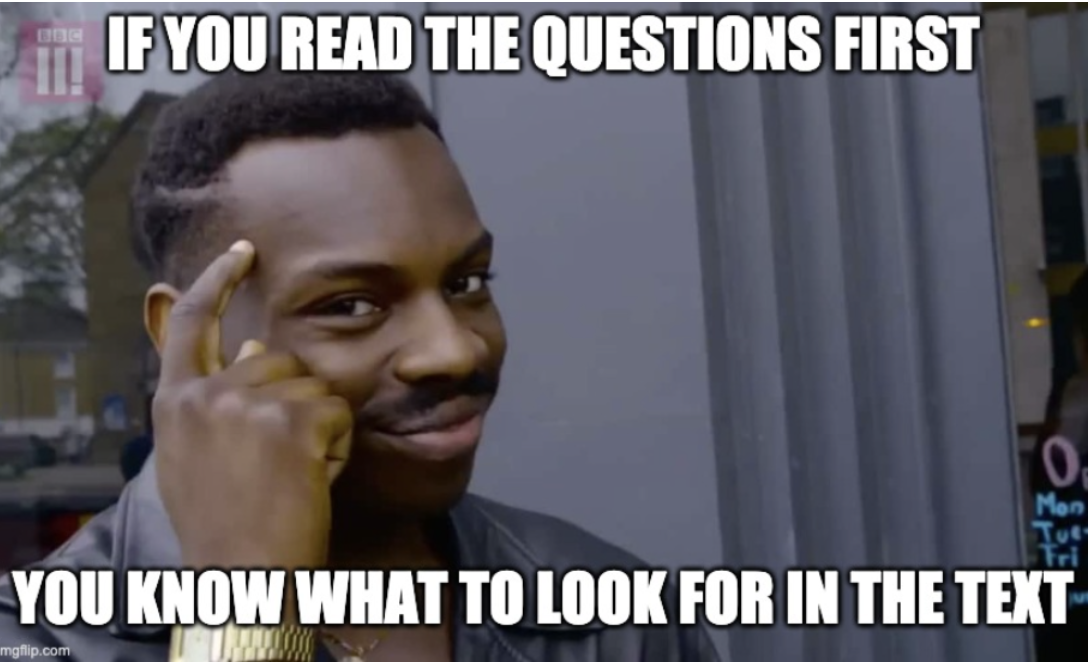AP Spanish Literature 💃🏽
24 resourcesSee Units
AP Spanish Literature Exam Guide
Multiple Choice Section
PART A, INTERPRETIVE LISTENING 👂
🏆 PRO TIPS
This part can be tricky, but feel confident with these pro tips:
- Read the questions before the audio starts.
- If you prep using this guide, you won't need to read the instructions, which will always be the same.
- Eliminate the opciones locos from the start.
- There will usually be 1-2 answers that just don't fit at all.
- Cross off. the opciones locos straight away, and then try to figure out which of the remaining are the best answer.
- If you know the author or the movement, use that to help zero in on the answer.
- Take notes during the audio.
- If you miss something, that's okay.
- Be sure to focus on the parts that you do understand.
- Read the instructions here in this study guide.
- When it comes to the exam, you can jump straight into reading the questions, since you already know what you're supposed to do in this section.
- Listen to more Spanish
- News videos that are about the same length of some of the audio for the exam:
- Podcasts with Radio ambulante—they are longer, but pick an episode and listen. They also have a transcript of the audio, so it can help you follow along.
- You can switch your favorite Netflix show over to Spanish too! 🍿 Or just put the subtitles on—it’ll help with the listening and writing sections.
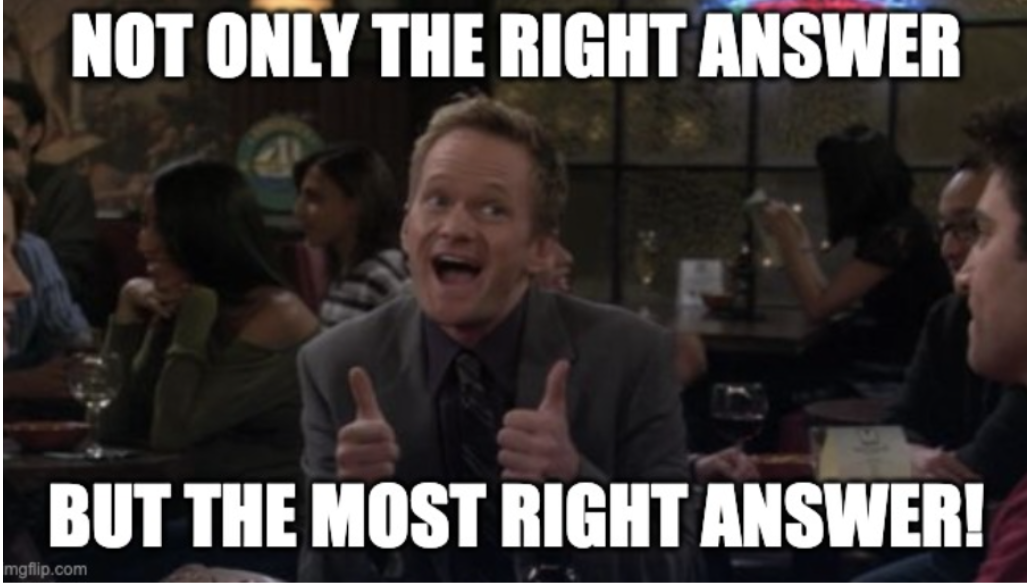
There are three different audio sections with 15 questions total.
- An interview with a writer 🎤
- You will only get to listen to this dialogue ONCE
- 4 questions
- The questions will go more or less in order
- The wording will be different, so use context clues for synonyms or antonyms that you can gather when reading the questions before the audio starts.
- The instructions in both English and Spanish on the exam will read:
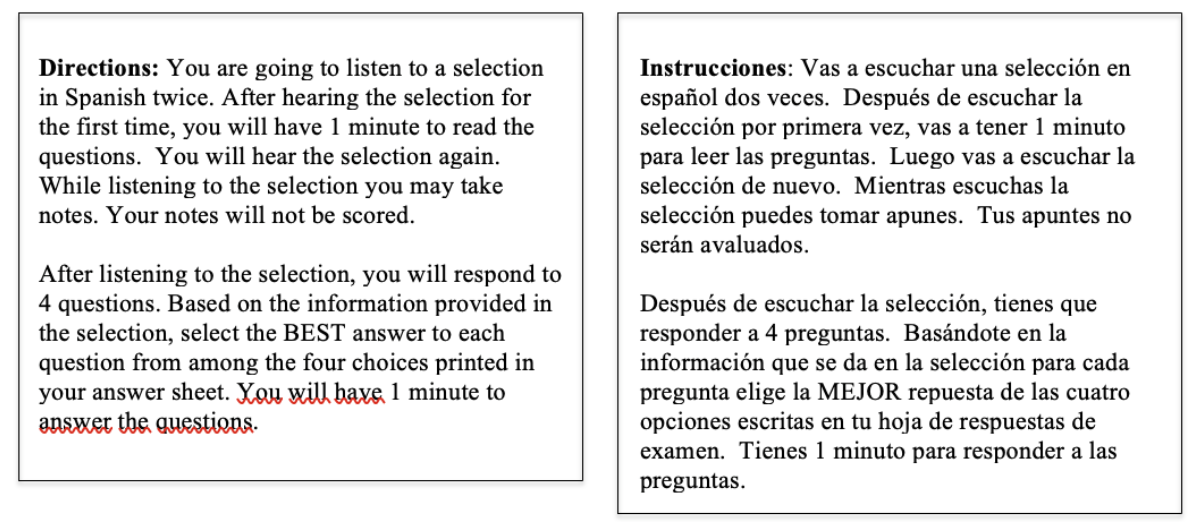
- Listening to a poem 📓
- You will get to hear this audio TWICE
- This will be a poem that is not on the required reading list, so you likely will not have heard it before, but it may be by a poet that you've read. Use your outside knowledge of the poet and the movement to help you.
- 4 questions
- The instructions in both English and Spanish will be the same on the AP Exam.
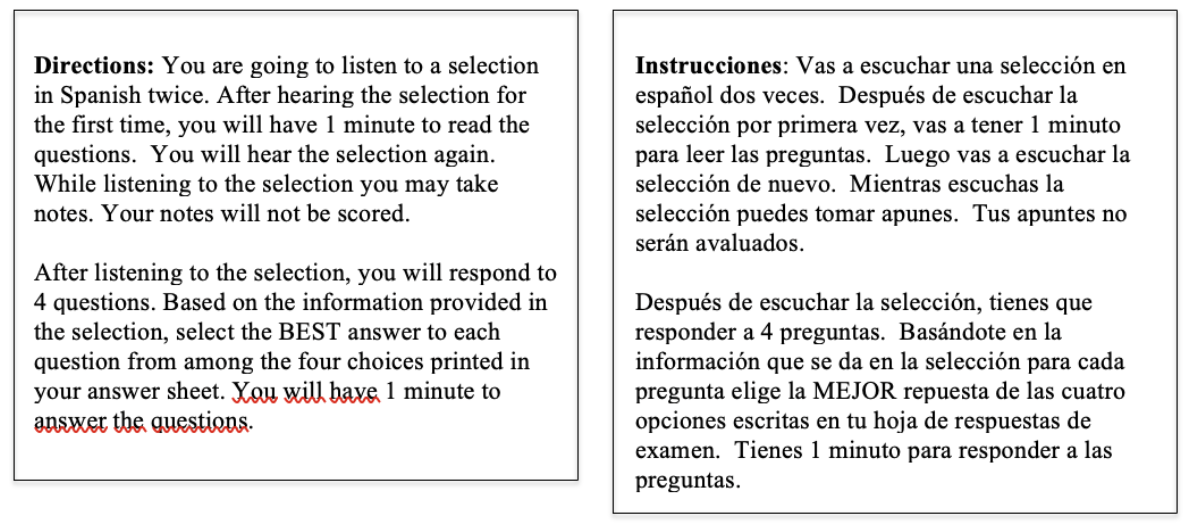
- Lecture on a literary topic 📚
- You will hear this audio ONCE.
- 7 questions
- This will likely be on a literary movement or an author from the required reading.
- The instructions:
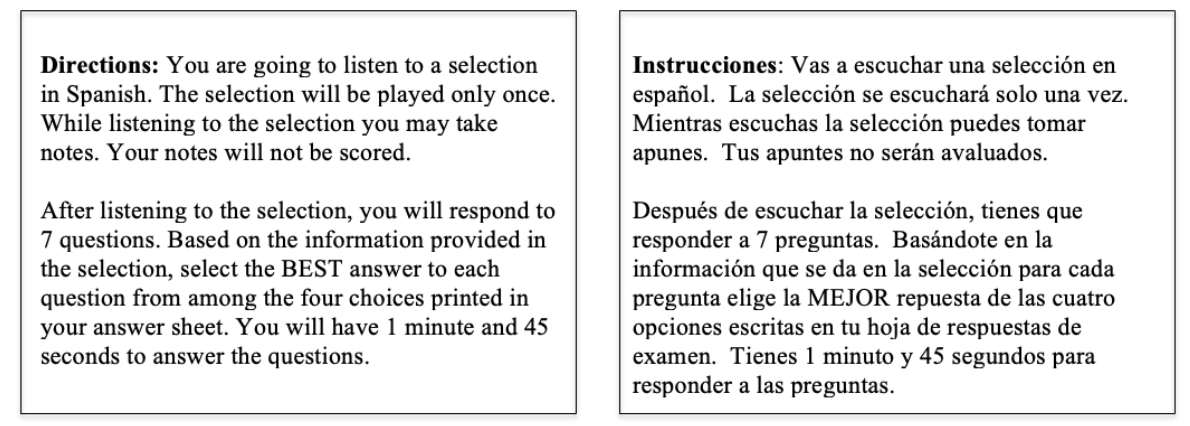
PART B, READING ANALYSIS:
🏆 PRO TIPS
These are going to look 👁️ a lot like the tips for the audio because you should apply them here too.
- Read the title and author first.
- If you know the writer or the time period, use that to help zero in on the answer.
- Then go straight to the questions BEFORE reading the text.
- Eliminate the opciones locos from the start.
- There will usually be 1-2 answers that just don't fit at all.
- Cross off the opciones locos straight away, and then try to figure out which of the remaining are the best answer.
- Know your rhetorical devices/literary terms
- These will be peppered throughout the entire multiple-choice section. (They'll also come in handy later from the writing section)
- In case you need a review, here's the list of terms with the definitions straight from the exam makers. They use this when designing the questions, expecting that you’ll know the terms.
- Some Quizlets from Fiveable
There are six different reading sections.
- Two of the sections are excerpts straight from the require reading list. No surprises there. 😺
- Two of the sections are excerpts from texts not on the required reading list.
- If you know the author or the literary movement, use that context.
- One text comparison section
- One of the texts is an excerpt from the required reading list
- The other text is one you probably haven't read, but is related thematically.
- Critical commentary section 🧐
- A piece written by a critic, like a review or analysis of a text, a literary movement, or a writer.
- The text, author, or literary movement the person writes about in this section likely relates directly to what you've studied for the class, so use that.
Writing Section ✍️
Pro Tips 🏆
The writing section can be a piece of cake 🍰 with these tips:
- Show off what you know.
- Focus on what you do know, and show that off.
- Try to tie in contextual information in the intros, like a reference to the time period and/or literary movement in which the author or poet wrote the piece.
- Budget your time.
- An hour and 40 minutes might seem like a lot, but when you break that down into four different essays, that’s not much time at all.
- Spend about 15 minutes on each of the two short-answer at the start.
- Spend about 30 minutes on each of the two essays at the end.
- For the longer essays, take a few minutes at the start to sketch a quick outline in your exam booklet.
- If you have the time, go back and read the essays to yourself in your head to catch any errors or add any last minute thoughts.
- Use direct quotes.
- Why do you think the texts are included in the exam? So that you USE them.
- The texts provide evidence to support your arguments. You need them.
- Identify the literary/rhetorical devices used in the text/s.
- They provide further evidence to support your arguments/main points.
- Explain the effect/s that the rhetorical devices have on the text.
- Mark up the texts.
- This will make it easy to come back to when making those direct quotes.
- It will also help you more easily identify the rhetorical devices
- Use the information provided about the text to help.
- All of the questions will include the name of the text.
- Questions 2-4 will also include the year and the name of the writers. Use all that to help!
- Use transition and connecting words
- This helps create a cohesive essay that flows logically.
- If you get stuck, here are some ideas:
primero, al inicio first, at the start después after, afterward al final, por final at the end, finally Sin embargo Nevertheless Querer decir to mean, to imply Tratar de to try, to be about a la vez at the same time por lo menos at least de vez en cuando from time to time en vez de instead of de acuerdo (con) okay, in agreement (with) sobre todo above all, especially a pesar de despite de nuevo again de hecho in fact de veras really a causa de because of por eso therefore por supuesto of course por lo visto evidently por un lado... por otro lado one one hand...on the other hand consecuencia consequently del mismo modo in the same way al igual que just like
Know Your Authors and Poets:
You have to know your authors and literary movements, especially for question 1, the short text explanation. Here's a quick visual:
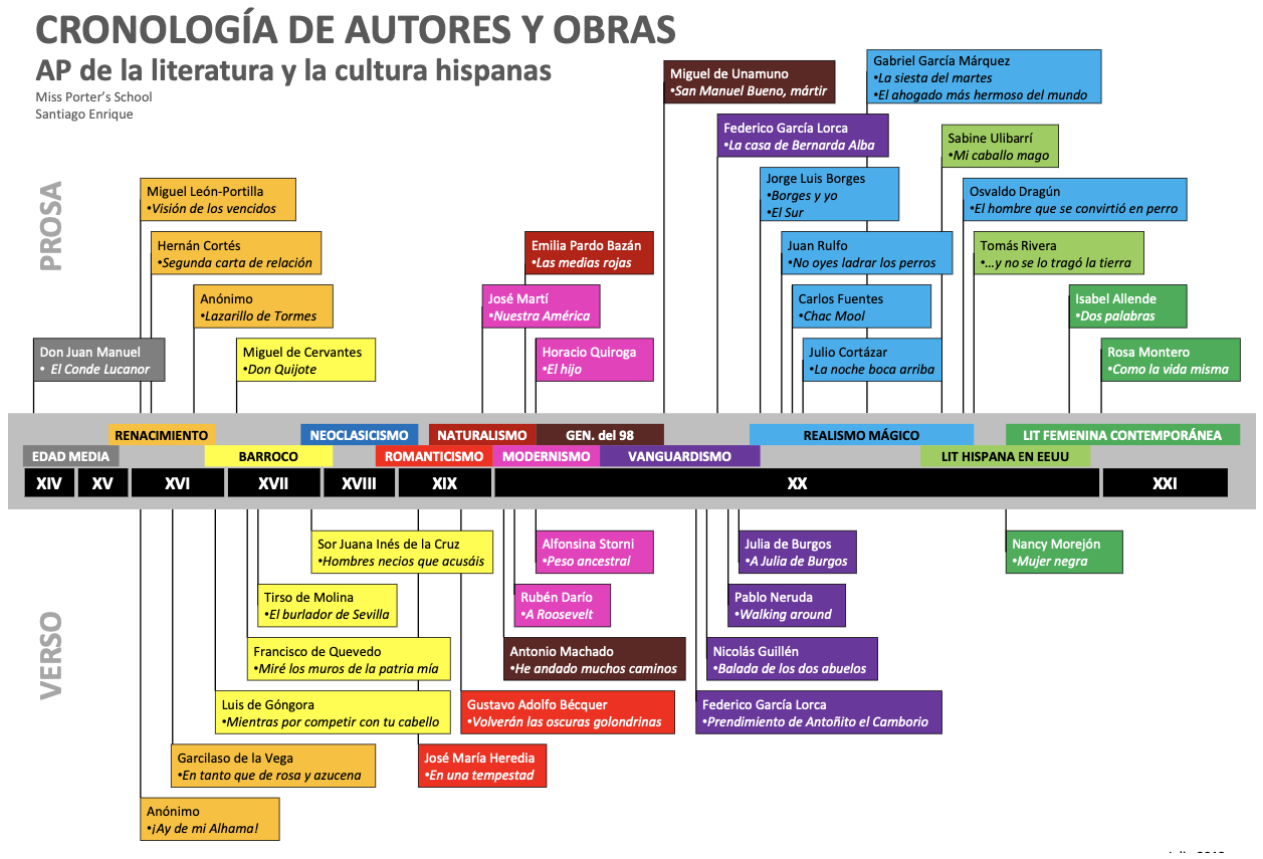
Image from S. Enrique (If that is a little hard to read, here’s the original PDF.).
Question 1: Short-Answer Text Explanation (Approx. 15 minutes) ✍️
NSTRUCTIONS: There will be a text here straight from the required reading list. You will write a short response to the prompt which relates a theme related to the six themes, and the more specific theme will be mentioned in the question. You have 1 hour and 40 minutes total for this section of the exam, and for this essay, you should use about 15 minutes total. Identify the author/poet and the time period/literary movement in which the text was written.
Los seis temas del curso:
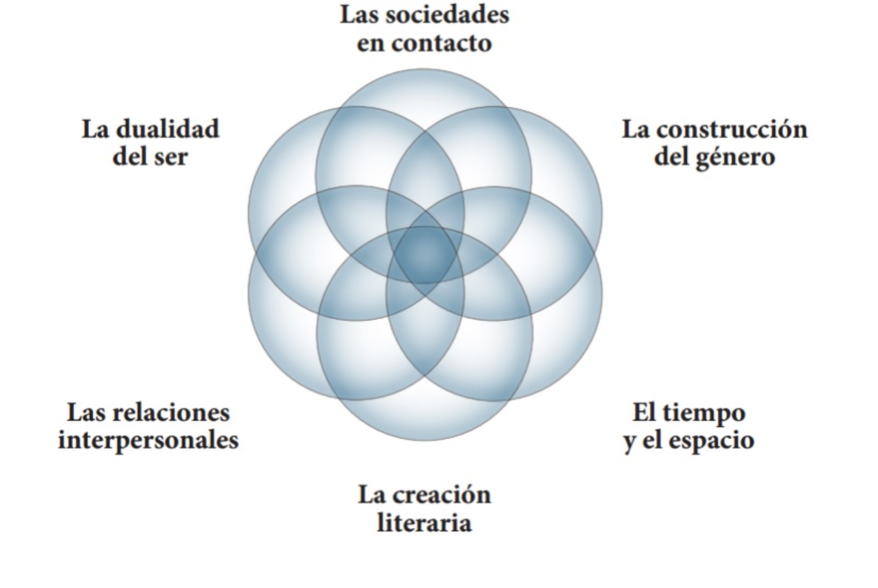
Recommended Structure:
- A brief introduction
- 1-2 sentence introduction
- Includes the name of the author/poet of the text and the literary movement they were a part of/ the time period 📅in which they were writing.
- Ties in the theme presented in the prompt to the text explanation that you will be providing in the main body paragraph
- Strong body paragraph
- Explains how the theme mentioned in the prompt (and your one-two sentence intro) is developed in the text provided
- Includes one-two direct quotes from the text provided (Make sure they aren’t too long.)
- Identifies one-two rhetorical devices used in the text and then ties it back to the theme
- Brief conclusion
- One to two sentences
- Ties everything together
- Synthesizes your main text explanation without repeating
🌟Exemplar Student Response
The following is a student response that received a 3 for content and a 3 for language based on the prompt. These are the exact instructions and the way it will appear on the exam.
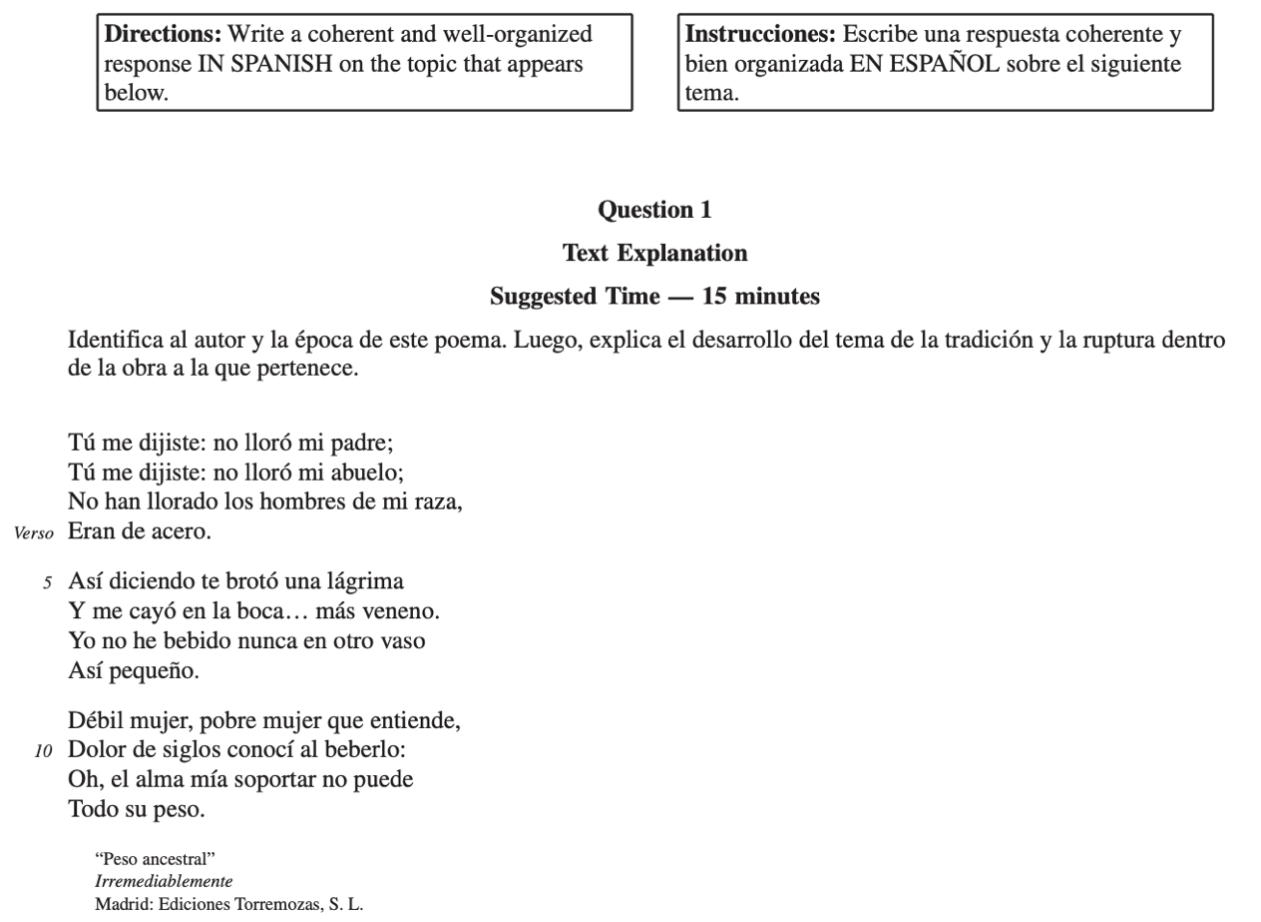
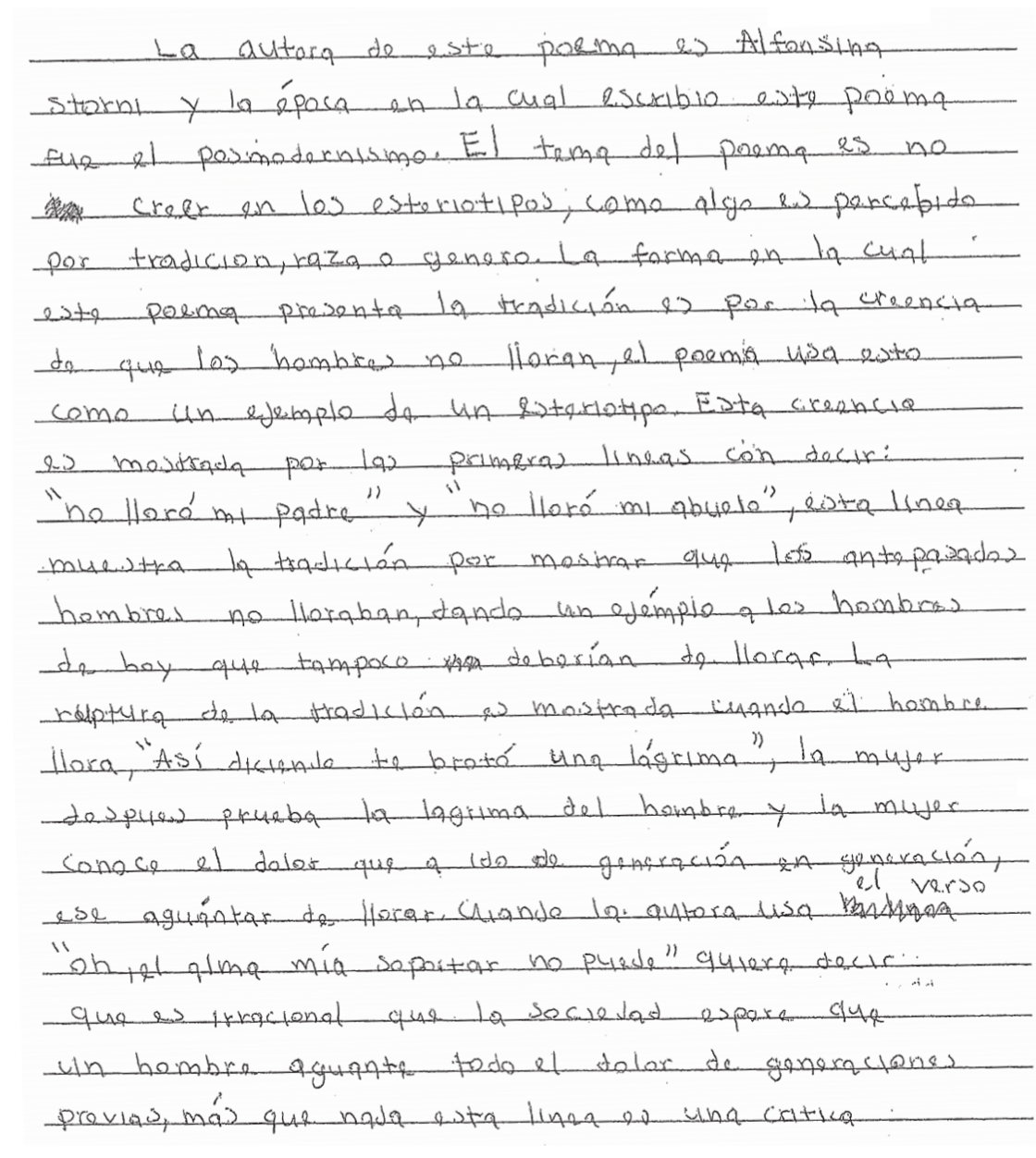
¡OJO! 👁️ The student here did make some small errors, and still earned the maximum number of points. For example, it says “línea” instead of “verso” 📋When you are writing about poems, it is verso. There are also some missing accents, but nothing interferes with the overall understanding of the student’s ideas. The student also directly addresses the theme presented in the prompt.
Question 2: Short-Answer Text and Art 🎨 Comparison (Approx. 15 minutes)✍️
INSTRUCTIONS: You will write an essay that compares the theme that is the same in the painting 🖼️and the text 📖.
Recommended structure (much like Question 1):
- Brief Introduction
- 1-2 sentence introduction
- Mention the literary movement, and possibly the connection or difference from when the painting was done
- Tie in the theme presented in the prompt to the text and the painting that you will be providing in the main body paragraph
- Strong body paragraph
- Explains how the theme mentioned in the prompt (and your one-two sentence intro) is present in the text and the painting
- Includes one-two direct quotes from the text provided (Make sure they aren’t too long.).
- Identifies one-two rhetorical devices used in the text and then ties it back to the theme
- Brief conclusion (if you have time)
- one to two sentences
- ties everything together
- synthesizes your main text explanation without repeating
🏆 PRO TIPS
Writing the Text and Art comparison can be tricky, but you go this!The most important things to remember are:
- Tie that theme to both works
- Use at least one direct quote and one literary device as your evidence for the theme in the text and then describe the visuals and how they related to the theme. That provides the evidence for the art.
- SYNTHESIZE the ideas and how they have similar effects through different mediums
- If you're running short on time, as long as your main body paragraph is solid, you'll be good.
- You don't have a lot of time. Stick to the theme and don't get trapped with too much detail here. Keep you eye on the clock ⏰
- Some vocab tricks 🪄 for the text and art comparison:
| la/s obra/s | work/s |
| la obra de arte / el cuadro | artwork / painting |
| ambo(a)s / los/las dos | both |
| al contrario / por el otro lado | to the contrary / on the other hand |
| semejante | similar |
❓Example Question 2
Lee la siguiente selección y estudia la pintura. Luego compara la representación de la metaficción en las dos obras en relación con el Boom latinoamericano.
Al otro, a Borges, es a quien le ocurren las cosas. Yo camino por Buenos Aires y me demoro, acaso ya mecánicamente, para mirar el arco de un zaguán y la puerta cancel; de Borges tengo noticias por el correo y veo su nombre en una terna de profesores o en un diccionario biográfico. Me gustan los relojes de arena, los mapas, la tipografía del siglo xviii, las etimologías, el sabor del café y la prosa de Stevenson; el otro comparte esas preferencias, pero de un modo vanidoso que las convierte en atributos de un actor. Sería exagerado afirmar que nuestra relación es hostil; yo vivo, yo me dejo vivir, para que Borges pueda tramar su literatura y esa literatura me justifica. Nada me cuesta confesar que ha logrado ciertas páginas válidas, pero esas páginas no me pueden salvar, quizá porque lo bueno ya no es de nadie, ni siquiera del otro, sino del lenguaje o la tradición. Por lo demás, yo estoy destinado a perderme, definitivamente, y sólo algún instante de mi podrá sobrevivir en el otro. Poco a poco voy cediéndole todo, aunque me consta su perversa costumbre de falsear y magnificar.
Spinoza entendió que todas las cosas quieren perseverar en su ser; la piedra eternamente quiere ser piedra y el tigre un tigre. Yo he de quedar en Borges, no en mí (si es que alguien soy), pero me reconozco menos en sus libros que en muchos otros o que en el laborioso rasgueo de una guitarra. Hace años yo traté de librarme de él y pasé de las mitologías del arrabal a los juegos con el tiempo y con lo infinito, pero esos juegos son de Borges ahora y tendré que idear otras cosas. Así mi vida es una fuga y todo lo pierdo y todo es del olvido, o del otro.
No sé cuál de los dos escribe esta página.
“Borges y yo”
Ficciones
Vintage español, 2012.
(La edición originalmente publicada de esta novela es de 1944).
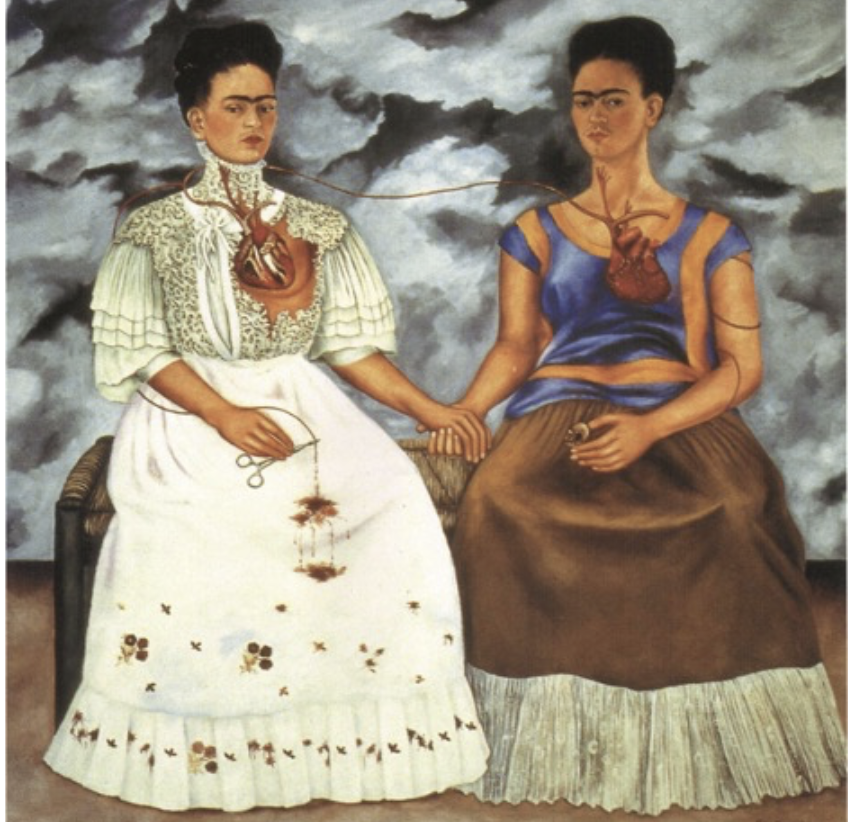
“Las dos Fridas,” Frida Kahlo 1953
✍️ Exemplar Student Response
The following is an exemplar student response that would receive a 3 in content and a 3 in language:
La metaficción, un tema popular durante el Boom latinamericano, permea las dos obras, el cuadro, “Las dos fridas” por Frida Kahlo y el cuento, “Borges y yo” por Jorge Luis Borges.
De inmediato, la idea de la metaficción es obvia por sus títulos, y se amplifica con la representación del doble en las dos obras. La artista, Frida Kahlo, tiene el papel central en su autorretrato, y no sola una Frida, pero “Dos Fridas” como sugiere el título. Por un lado hay una representación de una Frida en un vestido blanco formal. Por el otro lado, conectado por la sangre y sus corazones, le da la mano a la otra Frida vestida con la ropa más oscura y común. Son diferentes y separadas pero conectadas a la vez. Dos partes de la misma Frida. Semejantemente, en “Borges y yo”, Borges explora las dos partes de su identidad: una representación personal, “yo”, y una representación pública, “el otro”. Describe el “yo” como una persona simple, con gustos normales mientras “el otro comparte esas preferencias, pero de un modo vanidoso que las convierte en atributos de un actor.” Representa el Borges público quien no es un desconocido al “yo”, pero es separado. Como las dos Fridas, los dos Borges se conectan y se necesitan. Una gran diferencia de la representación del doble y la metaficción con las dos obras es que mientras Borges escribe sobre el acto de escribir, Frida no pinta sobre el acto de pintar. Se ve esta diferencia especialmente con la línea final, “No sé cuál de los dos escribe esta página.” Aún al final, el autor habla directamente a los lectores, como Frida Kahlo comunica directamente con la audiencia con su título, “Las dos Fridas”.
Ambas obras representan una ruptura con lo típico y se conectan personalmente con la audiencia por el tema de metaficción.
Question 3: Essay, Single Text ✍️
INSTRUCTIONS: You will write a longer essay that analyzes how the text represents a literary period, movement, genre, or technique. Rhetorical devices/literary figures are key 🔑 for this part.
Recommended structure
- Brief introduction
- 1-2 sentence introduction
- Mention the literary movement
- Tie in the theme presented in the prompt that you will develop in the body paragraph/s.
- First short body paragraph
- First body paragraph explains how the text demonstrates the theme mentioned in the prompt
- Includes at least one direct quote from the text provided. (Make sure they aren’t too long.)
- Identifies one-two rhetorical devices used in the text and then ties it back to the theme
- Keep it simple—5 tight sentences here will do the trick 🪄
- Second short body paragraph
- Explores a second way in which the theme mentioned in the prompt is represented in the text.
- Just like the first body paragraph this also includes a direct quote from the text and
- Identifies a rhetorical device used in the text that ties 🪢 back to the theme
- Keep it simple—5 tight sentences here will do the trick 🪄
- Brief conclusion
- One to two sentences
- Wraps everything up
- Synthesizes the main points in the two body paragraphs without repeating
❓Example Question 3

✍️ Exemplar Student Response
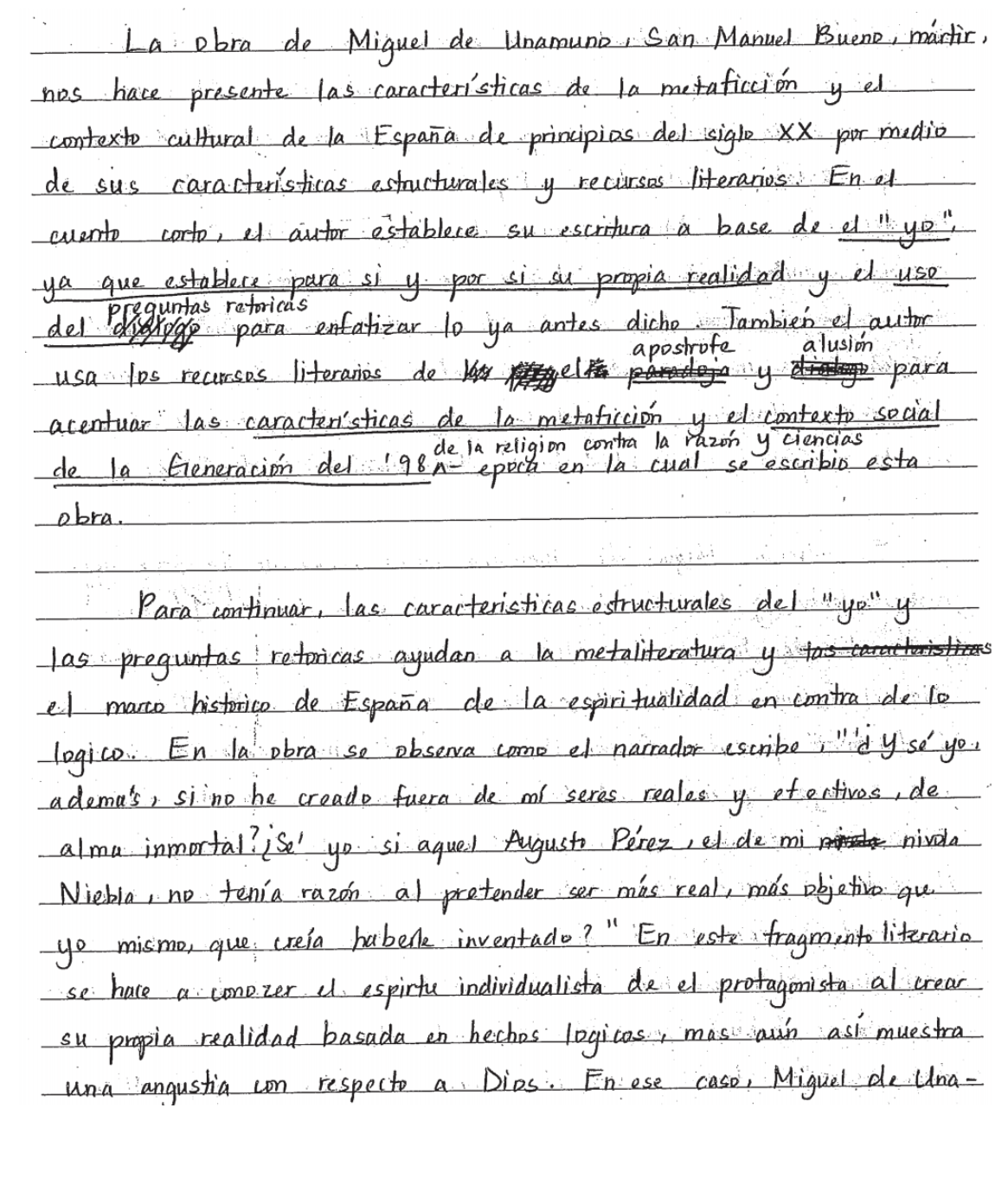
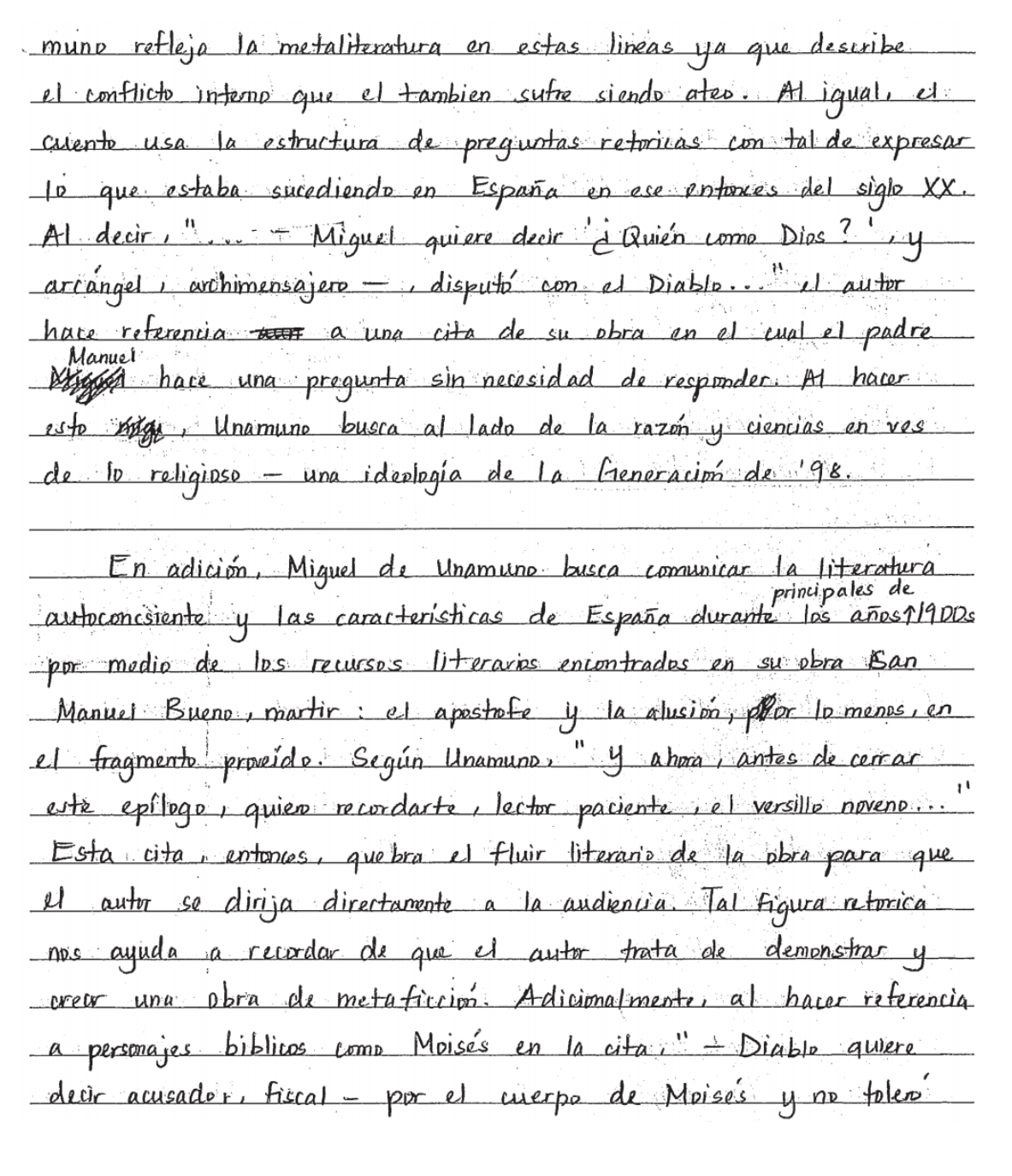
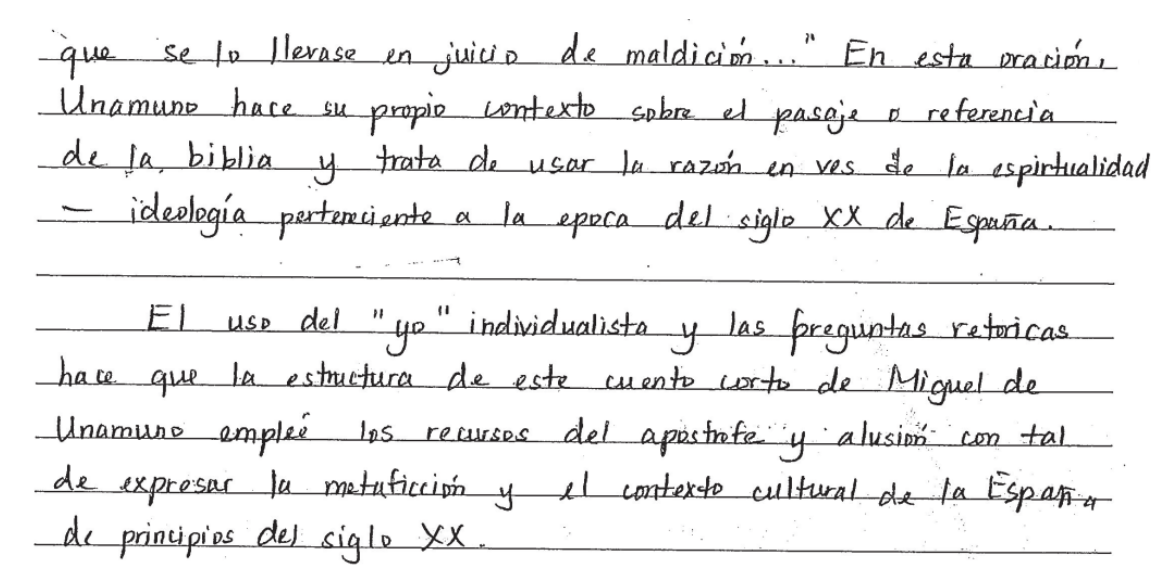
Question 4: Essay Text Comparison ✍️
INSTRUCTIONS: You will write an essay that analyzes two different texts 📖, one from the required reading list and one not. Focus here on rhetorical devices, connections in the texts and differences. Direct quotes from the texts also provide a strong 💪base to prove your argument.
Recommended structure (much like Question 3):
- Brief introduction
- 1-2 sentence introduction
- Mention the literary movement
- Tie in the theme presented in the prompt that you will develop in the body paragraph/s.
- First short body paragraph (similarities in the texts)
- Explains how the texts demonstrate the theme mentioned in the prompt relates/applies to both of the texts.
- Includes at least one direct quote from EACH text. (Keep them short and sweet.)
- Identifies at least one rhetorical device used in EACH text and then ties it back to the theme/idea mentioned in the prompt.
- Keep it simple—5 tight sentences here will do the trick 🪄
- Second short body paragraph (difference in the texts)
- Explains how the text DIFFER with the theme mentioned in the prompt
- Just like the first body paragraph this also includes a direct quote from EACH text and
- Identifies a rhetorical device used in EACH text and ties 🪢 it back to the theme
- Keep it simple—5 tight sentences here will do the trick 🪄
- Brief conclusion
- One to two sentences to wrap 🎁 everything up
- Synthesizes the main points in the two body paragraphs without repeating
❓Example Question 4
Analiza el efecto de los recursos literarios que los autores emplean en los dos fragmentos de “El ahogado más hermoso del mundo” por Gabriel García Márquez y “Dos palabras” por Isabel Allende para desarrollar el tema de la transformación. En tu ensayo, compara la presentación de este tema en los dos fragmentos. Debes incluir ejemplos de los textos que apoyen tus ideas.
✍️ Exemplar Student Response
¿Podemos transformar uno al otro? Es la pregunta que “El ahogado más hermoso del mundo” y “Dos palabras,” enfrentan en sus cuentos sobre un ahogado y un coronel. Aunque el primer enfoca en la transformación espiritual y al otro lado el segundo discuta la transformación emocional, los dos muestran el tratamiento habitual de las personas a cambiar otras. En sus cuentos, Marquez y Allende ambos emplean narradores omniscientes y el realismo mágico por mostrar la belleza de los pensamientos y su poder a transformar los hombres.
El uso del narrador omnisciente permite los lectores a entender los pensamientos y motivos de los personajes del cuento, y, por lo tanto, como pensamientos internos efectúan las transformaciones físicas. Los dos cuentos incorporan la voz de un narrador para mostrar los deseos internos de los personajes y como contribuyen a sus acciones. En “El ahogado más hermoso del mundo,” las mujeres sienten pena por el ahogado y quieren restaurar el digno que él perdió en su muerte. El narrador dice, “no pudieron reprimir un estremecimiento de compasión cuando tuvieron que resignarse a dejarlo tirado por los suelos.” Está compasión interna se motiva las mujeres a tratar el ahogado como un hombre en vivo, una transformación que tratan hacer con la ropa y con el nombre Esteban. Sino un narrador que sabe el intento de la gente, parecería raro que las mujeres actúan como un ahogado desconocido recibe esta recepción. El narrador omnisciente de “Dos palabras” produce el mismo impacto: Hace más fácil la comprensión de una transformación grande en el cuento por explicar los motivos. Aunque en “Dos palabras” la pena no inspirar el deseo de una transformación física (del muerte a la vida), es obvio que una transformación gran existe. Con un narrador desinformado, los lectores no sabrían que el coronel quiere transforma de un hombre temido a un hombre respectado. Es obvio en esta cita: “Llevaba muchos años, durmiendo a la intemperie, picado de mosquitos, alimentándose de iguanas y sopa de culebra, pero esos inconvenientes menores no constituían razón suficiente para cambiar su destino. Lo que en verdad le fastidiaba era el terror en los ojos ajenos. Deseaba entrar a los pueblos bajo arcos de triunfo, entre banderas de colores y flores, que lo aplaudieran y le dieran de regalo huevos frescos y pan recién horneado.” Sino la explicación, otra vez parecería raro que un cambio grande ocurre por dos palabras. Pero el narrador facilita la comprehension por explica que el coronel quiso transforma, solo necesitó la ayuda.
Todo por todo, los dos autores utilizan narradores omniscientes para ayudar los lectores a conectar con y entender más los personajes y sus acciones. Este entendimiento trae la atención a el tema grande en vez de los personajes.
¡OJO! 👁️ The student here did make some small errors, and still earned the maximum number of points. For example, a+al→ al and there are some accents missing. Nothing interferes with the overall understanding of the student’s ideas. The student also directly addresses the theme presented in the prompt.
Perfection here is not the goal. Show off what you know, and you’ve got this!
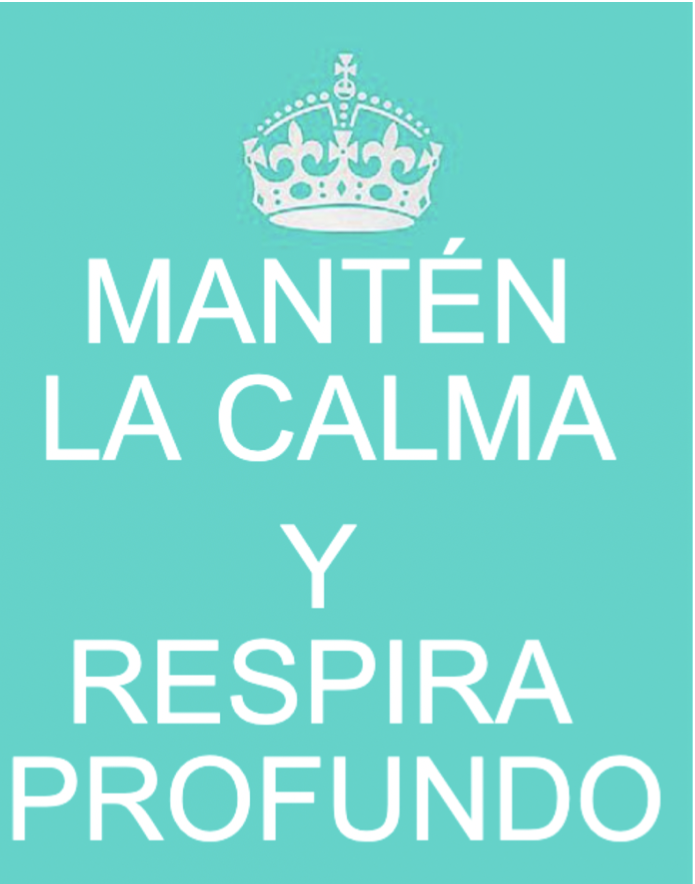
Browse Study Guides By Unit
🏇Unit 1 – La época medieval
🛳Unit 2 – El siglo XVI
🖌Unit 3 – El siglo XVII
✏️Frequently Asked Questions
🙏Exam Reviews

Fiveable
Resources
© 2023 Fiveable Inc. All rights reserved.
